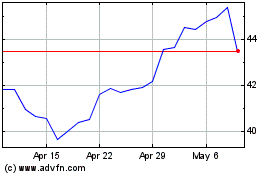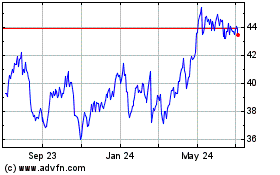Credit Markets: Beijing Policy Shift Boosts Yields -- WSJ
January 26 2017 - 3:02AM
Dow Jones News
By Rachel Rosenthal
Chinese government bond yields are approaching their highest
level since September 2015, after authorities overnight tightened a
key rate on loans to financial institutions.
The yield on China's benchmark 10-year government bond climbed
to 3.336% on Wednesday compared with 3.296% late Tuesday,
approaching a recent peak in mid-December when yields hit
3.387%.
Late Tuesday, China raised rates on an important tool that the
central bank uses to manage liquidity, called the medium-term
lending facility. Some analysts are interpreting the move as an
effective interest-rate increase, which would be the first such
step since 2011.
The decision is the latest evidence of Beijing fiddling with the
dials of monetary policy to tamp down rampant credit growth, while
simultaneously keeping enough liquidity in the financial system for
banks to meet funding needs and prevent market panic.
"Undoubtedly this is a tightening signal," said Pin Ru Tan,
director of Asia-Pacific rates strategy at HSBC Holdings PLC in
Singapore. "One of China's top priorities this year is to reduce
financial leverage, prevent asset bubbles and avoid a systemic
crisis."
Last week, the People's Bank of China pumped 1.13 trillion yuan
(roughly $165 billion) -- a weekly record -- into domestic money
markets ahead of the Lunar New Year holiday, when Chinese
traditionally give gifts of cash in red envelopes. The rush of cash
withdrawals tends to tighten liquidity this time of year,
particularly because markets will be closed from Jan. 27 through
Feb. 2.
Chinese officials have put deleveraging at the top of their
agenda for 2017, after a flood of cheap, post-financial-crisis
money pushed up prices of financial assets from real estate and
corporate bonds to iron ore and soybean-meal futures. China's money
supply has more than quadrupled since 2007, sending more cash after
a shrinking pool of appealing investment options, just as capital
controls keep money coursing through Chinese assets rather than
those abroad.
The build-up of credit in the bond market began in 2015, when
the central bank started holding short-term borrowing rates at very
low, stable levels to boost growth. By the summer of 2016, roughly
90% of interbank borrowing was in the overnight market, the
shortest and cheapest form of funding.
Many investors used the cheap cash to buy bonds and other
financial products, and then used those securities as collateral to
invest even more. Much of this borrowing was done through
off-balance sheet products, adding layers of leverage and financial
risk beyond regulators' view.
Officials started to crack down on this pattern in August, by
pushing borrowers to longer-term maturities, which elevates
short-term funding costs. The impact of this gradual tightening
campaign combined with a more hawkish U.S. Federal Reserve and
default scares triggered a deep selloff in the onshore bond market
in mid-December.
At that point, China halted trading in some bond futures
contracts for the first time, after 10-year and five-year futures
fell 2% and 1.2%, respectively. Currently, 10-year bond futures are
down 0.90% and five-year bond futures are down 0.50%.
Officials' deleveraging efforts have shown some signs of
success: The daily volume of overnight transactions has fallen to
1.96 trillion yuan from a peak of nearly 4 trillion yuan over the
summer, according to BNP Paribas. Now, roughly 70% of interbank
borrowing is in the overnight market.
China's decision to raise rates on medium-term lending
facilities by 0.1 percentage point -- to 2.95% for the six-month
and 3.10% for the one-year tenor -- isn't terribly dramatic. More
important, for market watchers, is the affirmation that officials'
tighter stance is here to stay.
"While the size of the rate increase is modest, the signal seems
clear that the PBOC has stepped up the tightening bias," wrote
economists at Goldman Sachs in a note.
Despite temporary bouts of volatility, there are some signs that
the long-term view on China's bond market is nevertheless
optimistic.
On Wednesday, Bloomberg announced that it would create two new
indexes, set to launch March 1, that will include China's onshore
government and policy bank bonds.
The move could accelerate inclusion into other closely tracked
international bond indexes, such as J.P. Morgan's emerging-market
government bond index, and accelerate foreign participation in
China's onshore bond market, said Becky Liu, a China macro
strategist at Standard Chartered. Foreigners currently own less
than 2% of China's onshore bond market.
Index providers have been charting China's progress in opening
up its financial markets as a condition for inclusion. Deutsche
Bank estimates that China's addition to some indexes could help
boost foreign investment inflows into China to $700 billion-$800
billion over the next five years.
Write to Rachel Rosenthal at Rachel.Rosenthal@wsj.com
Corrections & Amplifications The yield on China's benchmark
10-year government bond reached a peak in mid-December of 3.387%.
An earlier version of this article misstated the yield figure.
(Jan. 25)
(END) Dow Jones Newswires
January 26, 2017 02:47 ET (07:47 GMT)
Copyright (c) 2017 Dow Jones & Company, Inc.
HSBC (NYSE:HSBC)
Historical Stock Chart
From Mar 2024 to Apr 2024

HSBC (NYSE:HSBC)
Historical Stock Chart
From Apr 2023 to Apr 2024
